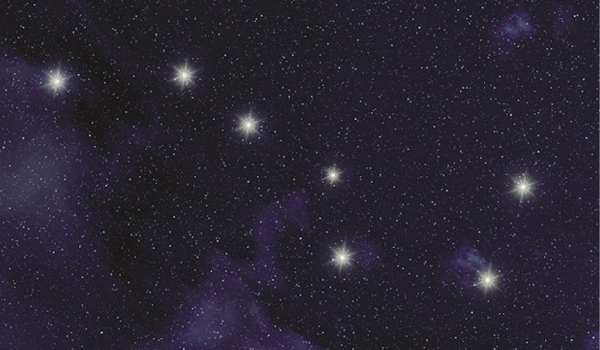
Various American Indian legends equate the Big Dipper with a grizzly bear. Photo Shutterstock
Chapter 7 Grizzly Bears and Humans
Grizzly Bears in History
The awe, fear, and fascination that modern people find in the grizzly bear were shared by many ancient peoples. Evidence of the dominant place the grizzly bear held in the lore and legends of our historical predecessors is amply illustrated in stories concerning stars. The name of the constellation Ursa Major means “great bear.” Ancient Greeks identified the stars of this constellation forming the shape of a bear. A legend concerning Zeus, the ruler of the gods, accompanied it. Zeus fell in love with a nymph, Callisto, who bore him a child. Zeus’s wife, Hera, was jealous and transformed Callisto into a bear. Later Callisto’s child, who had become a hunter, was about to inadvertently kill his mother. Zeus intervened, tossing both the bear-mother and her son into the sky, where they became the constellations Ursa Major and Ursa Minor. In the two constellations the “bears” have very long tails, unlike flesh-and-blood grizzly bears on earth. Evidently, Zeus used the long tails as handles for casting the bears into the sky.
Independently of the Greeks, American Indian peoples generated their own legends of a great bear in the sky. While the Greeks identified the bear with the entire constellation of Ursa Major, American Indians saw the bear in the stars of the Big Dipper. Technically speaking, the Big Dipper is not a constellation, but an obvious grouping of stars, known in the astronomical world as an “asterism.” An asterism is a smaller, more easily recognized portion of a constellation. Various American Indian tribes viewed the Big Dipper as a great bear (most likely a grizzly) being pursued by three hunters. The four stars composing the “cup” portion of the Big Dipper are the bear; the three stars composing the “handle” part of the asterism are the hunters. Throughout the seasons the movements of the Big Dipper across the northern sky recount a story of the interactions between the hunters and the hunted. The hunters discover the bear in the spring. All summer they pursue the bear across the night sky. In the fall they catch up to it and pierce it with their arrows. The bear rises on its hind feet, staining the earth with its blood, which corresponds to the red coloration in autumn foliage. All winter it is laid low in death, but as hibernating bears of the earth disappear below ground in late fall only to reappear in the spring, the great bear in the sky is also reborn. The story of the hunt is replayed every year in the movements of the Big Dipper across the night sky. Various tribes told differing versions of the story. Some replaced humans hunting the great bear with birds. Of the birds pursuing the grizzly bear, it was the robin that killed it, forever staining the feathers on its breast with the blood of the bear. This is why robins have a red breast.

Various American Indian legends equate the Big Dipper with a grizzly bear. Photo Shutterstock
In addition to the dramatic story staged in the heavens, American Indian tribes recounted numerous other legends regarding the grizzly bear, stories that involved the grizzly bear in relation to other animals as well as humans. Throughout the legends one dominant theme persists. The grizzly bear is the mightiest of the animals and very intelligent as well. Both humans and other animals are wise to remember this and give the bear its due respect.
The American Indians’ reverence toward the grizzly bear showed in activities other than their legends. Plains Indians felt that the powers of the grizzly bear, if appropriated by people, could guard warriors in battle and cure or insulate individuals from illness. Native peoples of the Pacific Northwest commonly adorned totem poles, dishes, and other items with images of bears. Hunters from some tribes pursued and killed grizzly bears as a sign of a warrior’s exceptional courage and skill. Grizzly bear claws and hides decorated the clothing of some tribes, and the meat of a grizzly bear would be consumed as well. Other groups left bears alone, prohibiting the eating of bear meat.